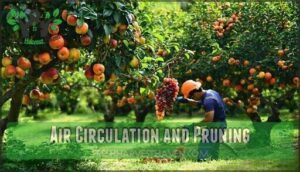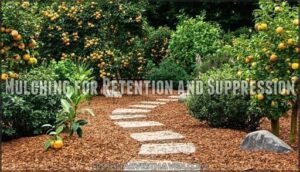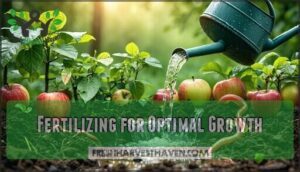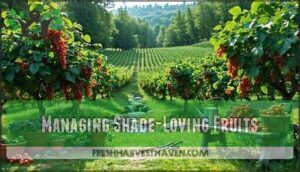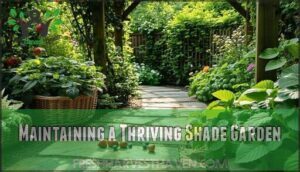This site is supported by our readers. We may earn a commission, at no cost to you, if you purchase through links.

Focus on shade-tolerant varieties like elderberries, currants, and gooseberries that thrive with 4-6 hours of sunlight daily.
Pawpaw trees are exceptional choices for deeper shade, producing tropical-flavored fruits most gardeners never consider.
You’ll want to assess your garden’s light patterns throughout the day, since morning sun often works better than afternoon shade.
Improve soil drainage and add organic matter, as shaded areas tend to stay wetter longer.
Strategic pruning helps maximize available light while preventing fungal issues common in humid, low-light conditions.
The secret lies in understanding which fruits actually prefer gentler growing conditions.
This approach will help you successfully grow fruit in shady spots, making the most of the available light and conditions.
Table Of Contents
- Key Takeaways
- Choosing Shade-Tolerant Fruits
- Assessing Your Shaded Garden
- Preparing Your Shaded Garden
- Managing Shade-Loving Fruits
- Maintaining a Thriving Shade Garden
- Frequently Asked Questions (FAQs)
- Do any fruits grow well in the shade?
- What will grow in 100% shade?
- Does anything edible grow in shade?
- What fruit needs direct sunlight?
- Can fruit trees grow in shade?
- How do you grow a tropical fruit tree in the shade?
- Should you grow fruit in a shade tolerant garden?
- Are fruit trees shade tolerant?
- Which fruits grow in shade?
- How do I choose a shade-loving fruit tree?
- Conclusion
Key Takeaways
- Choose shade-tolerant varieties that thrive with 4-6 hours of sunlight daily—elderberries, currants, gooseberries, and pawpaws will give you reliable harvests where full-sun fruits struggle.
- Assess your garden’s light patterns throughout the day, since morning sun often works better than afternoon shade, and track seasonal changes to understand exactly what you’re working with.
- Improve soil drainage and add organic matter, since shaded areas stay wetter longer, creating perfect conditions for root rot and fungal problems if you don’t address moisture management.
- Prune strategically for airflow and light penetration by removing crossing branches and thinning dense growth—this prevents fungal diseases common in humid, low-light conditions while maximizing available sunlight.
Choosing Shade-Tolerant Fruits
You don’t need full sun to grow delicious fruit in your backyard.
Many berries, trees, and vines actually prefer partial shade and will reward you with sweet harvests when you choose the right varieties for your growing conditions.
Berries for Shaded Areas
Transform your shady garden spaces into productive berry havens with the right shade tolerant fruit varieties. These resilient berries adapt to limited sunlight while delivering impressive harvests.
Your shade gardening success depends on selecting proven performers:
- Lowbush blueberries thrive under vegetation canopies, producing sweet berries in acidic soil
- Elderberries excel in partial shade with rich, moist conditions
- Currants and gooseberries represent the most shade-loving berries, perfect for forest edges
- Blackberries and raspberries adapt well to filtered light along woodland borders
- Alpine strawberries work as groundcover while producing fruit in dappled shade
Managing soil acidity proves essential for blueberries, which need pH levels between 4.5-5.5. Monitor moisture levels carefully since shaded areas retain 30% more water, affecting pest resistance.
Blueberries demand acidic soil—test and adjust pH or watch your harvest disappear.
Many fruits, including sour cherry trees, can still produce a harvest in partial shade. Most shade loving berries require minimal pruning needs compared to sun varieties, making maintenance simpler for busy gardeners.
Shade-Tolerant Trees
Patience becomes your greatest asset when selecting shade tolerant fruit trees for dimmer garden spaces. Most fruit trees shade varieties need careful consideration of their specific light requirements and growth habits.
Tree Selection for Shaded Gardens:
- Pawpaw trees – These native gems thrive in dappled forest conditions, producing custard-like tropical fruits while handling root competition from larger trees
- Morello cherries – Perfect for cooler climates, they’ll flourish against shady walls with just morning sunlight exposure
- Hazelnuts – These hardy nuts adapt well to partial shade conditions and require minimal pruning techniques
When choosing shadetolerant trees, you’ll want to assess each variety’s specific needs. Pawpaws naturally prefer understory environments, making them excellent fruit for shade locations. Morello cherries excel in partial sun conditions, while hazelnuts tolerate reduced light better than most nut trees.
Consider your garden’s microclimates and existing root competition when planning placement. Certain varieties of blackcurrant are adaptable to low-sun conditions. These shade fruit varieties often develop more complex flavors than their full-sun counterparts.
Other Fruits for Partial Shade
Your shaded garden holds hidden potential for unique fruit varieties that’ll surprise you with their productivity.
Beyond traditional berries and fruit trees, several specialty fruits thrive in partial shade conditions:
- Rhubarb produces tender stalks for pies with just morning sunlight
- Alpine strawberries offer continuous harvests as groundcover in dappled shade
- Quince trees develop aromatic fruits even with limited sun exposure
Native fruits like pawpaws and serviceberries naturally grow in woodland conditions, making them perfect shade fruit varieties.
Container fruits work well too—you can move them seasonally for ideal light.
Some leafy greens, like spinach, also benefit from partial shade conditions.
Indoor fruit growing with grow lights extends your options further.
These resilient plants prove that fruit in partial shade doesn’t mean compromising on flavor or yield.
Assessing Your Shaded Garden
Before you start planting shade-tolerant fruits, you need to understand what you’re working with in your garden space.
A proper assessment of your shaded areas will help you choose the right varieties and set realistic expectations for your harvest.
Evaluating Sun Exposure
Four essential steps will help you map your garden’s light patterns effectively. Every shaded garden has unique sunlight exposure that changes throughout the day and seasons.
Start by documenting your garden’s light levels with these practical methods:
- Take hourly photos from sunrise to sunset to track shifting shade patterns
- Use a light meter to measure exact light levels in different garden zones
- Monitor sun duration in potential planting spots throughout the day
- Create a shade map showing where dappled sunlight filters through trees
- Track seasonal changes as leaf cover affects light monitoring results
Download sun-tracking apps for precise measurements of your garden’s microclimates. These tools help you understand how tree canopies and structures create varying sunlight exposure patterns. Pay attention to morning versus afternoon light, as many shade-tolerant fruits prefer gentler morning sun over intense afternoon heat.
Soil and Moisture Considerations
Healthy soil acts as your garden’s foundation, especially in shaded areas where moisture tends to linger. Begin with soil pH testing – most fruits thrive between 6.0-7.0, though blueberries prefer acidic conditions around 4.5-5.5.
Soil preparation becomes essential for success. Mix organic compost and amendments into existing soil to improve structure and nutrient retention. This creates well-drained soil that holds moisture without becoming waterlogged.
Waterlogging prevention requires attention since shaded areas retain 30% more moisture than sunny spots. Your soil should feel like a wrung-out sponge – damp but not soggy. Organic amendments help achieve this balance while boosting fertility.
Implement weekly moisture monitoring to fine-tune your watering schedule. Check soil depth with your finger – if it’s dry beyond two inches, it’s time to water. Effective moisture management and moisture retention strategies will keep your shade-loving fruits healthy and productive throughout the growing season.
Air Circulation and Pruning
Once you’ve addressed soil moisture needs, proper air circulation becomes your next priority for healthy shade-grown fruit.
Think of your shaded garden as needing room to breathe. Dense, crowded branches create stagnant pockets where diseases love to settle. Your pruning techniques will open up these spaces and improve airflow benefits.
Smart branch management involves removing crossing limbs and thinning overcrowded areas. This disease prevention strategy allows air to move freely through your plants while increasing light penetration to lower branches.
Fruit tree pruning techniques work best during late winter when plants are dormant. Focus on shade management techniques that promote airflow improvement without removing too much foliage. To further support plant health, consider implementing a summer garden maintenance checklist.
- Watch fungal problems disappear as fresh air reaches every branch
- Feel confident knowing your plants can resist common shade diseases
- Experience the satisfaction of healthier, more productive fruit harvests
Preparing Your Shaded Garden
Getting your shaded garden ready means working with what nature gives you instead of fighting against it.
Start by improving your soil with compost, adding mulch to keep moisture in and weeds out, then choose fertilizers that won’t burn plants in low-light conditions. Start by improving.
Amending Soil With Compost
Transform your shaded garden soil into a thriving foundation using compost amendments. This organic powerhouse creates the perfect environment for shade-loving fruits by addressing multiple soil challenges simultaneously.
- Compost soil structure: Breaks up clay and adds body to sandy soils
- Compost water retention: Holds moisture without creating waterlogged conditions
- Compost nutrient availability: Releases nutrients slowly for sustained plant growth
- Compost pH balance: Gradually neutralizes acidic or alkaline soils
Work 2-3 inches of well-aged compost into your soil preparation process, keeping it several inches from plant stems. This soil amendment improves compost soil fertility while enhancing overall soil health.
The result is nutrient-rich soil that supports robust fruit production even in challenging shade conditions. Effective use of compost soil amendments involves understanding compost benefits to maximize their impact on soil quality.
Mulching for Retention and Suppression
Your amended soil needs protection, and mulching delivers exactly that.
Soil mulching acts as your garden’s guardian, creating the perfect environment for shade-loving fruits to flourish.
Mulch is your garden’s superhero cape, nurturing and protecting fruits in the shadowy domain of low light.
Strategic mulching transforms your shade garden through moisture retention and weed suppression.
Organic matter like pine needles, shredded leaves, or wood chips works best for shade optimization.
| Mulch Type | Benefits | Best For |
|---|---|---|
| Pine Needles | Acidic, lightweight | Blueberries, brambles |
| Shredded Leaves | Rich nutrients | All shade fruits |
| Wood Chips | Long-lasting | Tree fruits |
| Straw | Good airflow | Berry patches |
| Bark Mulch | Attractive appearance | Ornamental areas |
Apply a 2-3 inch layer around plants, keeping mulch away from tree trunks to prevent rot.
Light-colored mulches reflect available sunlight back to plants, maximizing photosynthesis in low-light conditions.
Well-drained soil benefits from mulching’s moisture-regulating properties.
Your soil preparation pays off when mulch maintains consistent dampness without waterlogging.
This foundation sets up your shade gardening success.
Effective soil preparation techniques are vital for a thriving garden, providing the perfect environment for growth and ensuring optimal results with proper care and attention to detail.
Fertilizing for Optimal Growth
With your mulch barrier in place, proper nutrition becomes the next priority for your shade-loving fruits.
Soil testing reveals pH levels and nutrient gaps—target that 6.0 to 6.5 range for most fruits.
Organic fertilizers work best in shaded conditions, releasing nutrients slowly without burning roots.
Mix compost directly into planting areas to create nutrient-rich soil that supports microbial balance.
Spring applications of balanced fertilizers work wonders, but reduce nitrogen in shade since plants grow slower.
Focus on phosphorus for flowering and potassium for fruit development.
Nutrient cycling happens naturally when you add organic matter regularly.
Compost tea provides an extra nutritional boost—steep finished compost in water for 24 hours, then apply weekly.
This liquid gold feeds both plants and beneficial soil organisms while improving moisture retention in your shaded garden beds.
Using organic fertilizer options can enhance the overall health of your shade garden.
Managing Shade-Loving Fruits
Once you’ve planted your shade-tolerant fruits, proper care becomes essential for healthy growth and good harvests.
Managing these plants requires specific techniques for pruning, watering, and protecting them from pests that thrive in shadier conditions.
Pruning for Light and Air
Strategic pruning techniques transform your shaded fruit trees into productive powerhouses by maximizing light penetration and air circulation.
Focus on removing crossing branches and creating openings in dense canopies through careful branch removal and tree thinning.
- Open your tree’s heart – Remove interior branches that block sunlight from reaching developing fruits
- Create breathing room – Thin overcrowded areas where branches compete for space and nutrients
- Shape for success – Cut lower limbs strategically to allow dappled light to filter through
Canopy thinning requires precision cuts just above leaf nodes at 45-degree angles.
This shade management technique promotes healing while preventing disease entry points.
Your fruit tree pruning efforts will reward you with improved light distribution and stronger air circulation throughout the growing season.
Effective use of tree pruning tools is vital for achieving superior results in fruit tree maintenance.
Watering Strategies for Shaded Fruits
Proper watering separates successful shade gardeners from frustrated ones. You’ll discover that shade fruit production demands different moisture management than sun-grown plants.
Shaded areas retain 30% more soil moisture than sunny spots, creating unique challenges. Your plants need consistent moisture without becoming waterlogged in poorly drained conditions.
Here’s your watering blueprint:
- Check soil moisture two inches deep before watering – stick your finger right into the dirt
- Install drip irrigation systems for precise water delivery without wetting foliage
- Time watering for early morning to reduce evaporation and fungal issues
Rainwater harvesting works exceptionally well for shade hydration since these areas use water more efficiently. Your shade-loving fruits actually prefer steady, moderate moisture over heavy watering sessions.
Monitor your plants closely during seasonal changes. Reduce watering frequency during rainy periods and increase during dry spells. This balanced approach guarantees maximal water retention while maintaining the well-drained soil conditions your shade fruits need to thrive.
Pest and Disease Management
Your watering routine sets the stage, but now you need to protect your shade-grown fruits from pest problems and fungal diseases. Shaded gardens create humid conditions that attract insect pests and encourage disease development.
| Issue | Signs | Organic Solutions |
|---|---|---|
| Aphids | Curled leaves, sticky honeydew | Release ladybugs, spray neem oil |
| Powdery Mildew | White coating on leaves | Improve air circulation, copper fungicide |
| Fruit Flies | Damaged, rotting fruit | Yellow sticky traps, remove fallen fruit |
| Scale Insects | Yellowing leaves, sticky residue | Horticultural oil, beneficial insects |
| Bacterial Canker | Sunken spots on fruit | Prune infected areas, avoid overhead watering |
Weekly pest inspection helps catch problems early. Remove fallen fruit immediately to prevent attracting pests. Biological management works well in shade gardens—encourage beneficial insects that naturally control harmful ones.
Effective fruit garden pest control methods can make a significant difference in maintaining a healthy shade garden. For fungal control, space plants properly to improve airflow. Disease prevention starts with good garden hygiene and selecting resistant varieties when possible.
Maintaining a Thriving Shade Garden
Once you’ve established your shade fruit garden, consistent maintenance keeps your plants healthy and productive.
Regular monitoring prevents small problems from becoming major issues while seasonal adjustments guarantee your garden thrives year-round, through regular care.
Regular Maintenance Tasks
Your shade garden’s success depends on consistent care that adapts to changing seasons.
Regular maintenance keeps your fruit plants healthy and productive despite limited sunlight conditions.
Focus on these core maintenance activities:
- Soil Testing twice yearly to monitor pH levels and nutrient balance for ideal fruit production
- Prune Timing during late winter months when plants are dormant, removing crossing branches for better light penetration
- Water Scheduling that adjusts to rainfall patterns while maintaining consistent moisture management throughout growing seasons
- Mulch Application around plant bases to retain soil moisture and suppress competing weeds
Monthly pruning sessions help thin dense growth and maximize available light reaching your fruit plants.
Check soil moisture weekly, adjusting irrigation based on seasonal needs.
Fruit Thinning in early summer prevents branch breakage and improves remaining fruit quality.
Apply organic fertilizer during spring growth periods when plants actively absorb nutrients.
Monitoring for Pests and Diseases
Biweekly insect inspection rounds catch problems before they explode. Check leaves for holes, sticky residue, or unusual spots that signal pest control needs.
Fungal disease prevention starts with removing infected plant material immediately—don’t let it spread. Apply organic remedies like neem oil for aphids or copper spray for leaf spot.
Disease prevention works best when you act fast. Shaded areas trap moisture, creating perfect conditions for fungal management challenges.
Watch for fruit tree pest problems like scale insects on bark. Plant diseases love humid conditions, so improve air circulation through strategic pruning.
Your vigilant monitoring prevents small issues from becoming garden disasters.
Adjusting to Seasonal Changes
Throughout the changing seasons, your shade-tolerant fruit varieties need careful attention to thrive in low-light conditions.
Each season brings unique challenges for growing fruit in shade that require specific shade gardening practices.
Here’s your seasonal action plan:
- Winter Protection: Wrap young trees and add extra mulch around shade-tolerant fruit varieties to protect roots from freezing temperatures.
- Spring Awakening: Begin seasonal pruning when buds appear, opening pathways for limited sunlight to reach fruiting branches.
- Summer Monitoring: Check soil moisture regularly since shade adaptation can mask drought stress in your fruit trees.
- Autumn Harvest: Collect fallen fruit promptly and clear debris to prevent disease issues common in shaded areas.
- Dormancy Planning: Track each variety’s fruit dormancy patterns to understand their unique seasonal needs.
Your shade garden’s success depends on adapting fruit production techniques for shade throughout the year.
Keep detailed records of each plant’s performance to master these seasonal changes and maintain consistent harvests.
Frequently Asked Questions (FAQs)
Do any fruits grow well in the shade?
Nature’s understudies often outshine the stars—raspberries produce sweet berries with just morning sun, while blueberries thrive in dappled light.
You’ll find success with blackberries, currants, gooseberries, and pawpaws in shaded spots.
What will grow in 100% shade?
Unfortunately, no fruits will thrive in 100% shade.
Even shade-tolerant varieties like pawpaws, elderberries, and currants need at least 3-4 hours of filtered sunlight daily for photosynthesis and fruit production to occur successfully.
Does anything edible grow in shade?
Shade-savvy gardeners can successfully cultivate currants, gooseberries, elderberries, and lowbush blueberries. You’ll find raspberries, blackberries, and hardy kiwi vines also produce decent harvests in partial shade conditions.
What fruit needs direct sunlight?
Most fruit trees like citrus, apples, cherries, and peaches need full sun—that’s 6-8 hours daily.
You’ll get bigger harvests and sweeter fruit when they soak up maximum sunlight for ideal photosynthesis.
Can fruit trees grow in shade?
Yes, you can grow fruit trees in shade.
Many varieties like pawpaws, pears, and plums thrive with just four to six hours of sunlight daily.
Choose partial-shade tolerant species and expect smaller but still delicious harvests.
How do you grow a tropical fruit tree in the shade?
Choose tropical varieties like pawpaws that handle partial shade well.
Plant in well-draining, organic-rich soil with consistent moisture.
Provide 4-6 hours of dappled sunlight daily and protect from harsh afternoon sun.
Should you grow fruit in a shade tolerant garden?
Picture a hidden garden oasis where dappled sunlight filters through leafy canopies—you’ll find nature’s sweetest rewards thriving there.
Growing shade-tolerant fruits like blueberries, raspberries, and currants transforms challenging spaces into productive harvests with proper soil preparation, allowing for a bountiful harvest.
Are fruit trees shade tolerant?
Most fruit trees aren’t truly shade tolerant, but some varieties can handle partial shade.
Pawpaws, pears, and plums need just six hours of direct sunlight daily, while full-sun trees require eight-plus hours for maximum fruit production.
Which fruits grow in shade?
Under dappled canopies where sunlight filters through leaves, you’ll find blueberries, raspberries, blackberries, currants, gooseberries, elderberries, and pawpaws.
These plants thrive in partial shade conditions with just four to six hours of daily sun.
How do I choose a shade-loving fruit tree?
Look for varieties that need only 4-6 hours of daily sun like pawpaws, pears, or plums.
Check your site’s light patterns, test soil pH, and select disease-resistant cultivars suited to your climate zone.
Conclusion
Success in shade gardening is like finding treasure in unexpected places—you’ll discover abundant harvests where others see only limitations.
Your tips for growing fruit in shade will transform difficult spots into productive areas. Choose elderberries, currants, and pawpaws for reliable yields.
Assess your light patterns carefully, improve drainage with organic matter, and prune strategically. With proper variety selection and smart management techniques, you’ll create thriving fruit gardens even in challenging conditions, leading to abundant harvests.
- https://www.gardeningknowhow.com/edible/fruits/fegen/fruit-bearing-shade-plants.htm
- https://practicalselfreliance.com/shade-tolerant-fruiting-plants/
- https://www.permaculturenorthernbeaches.org.au/growing-food-in-shady-places
- https://www.foxrunenvironmentaleducationcenter.org/organic-gardeningself-sufficiency/2024/3/28/fruit-for-partial-shade
- https://www.growveg.com/guides/growing-fruit-in-shade/



